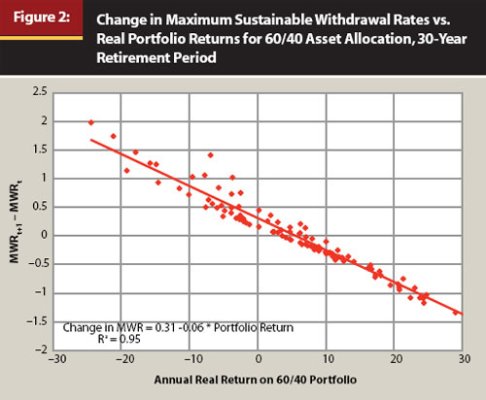Let me take a stab at this one - I kind of disagree with the path of some of the other explanations, though I see where they are coming from -
Joe retires in 2016, with $1M and a planned 4% SWR for 30 years with a 94% rate and 75/25 stock bond mix.
In 2017, the market crashes. Joe's portfolio drops 40% to $600,000. Mary wants to retire in 2017 for 29 years with a portfolio of $600,000, and a 75/25 mix and a 4% SWR, but Firecalc says she only has a 43% chance of success.
First, I believe you misstated the problem. I assume you mean that Mary wants to withdraw
the same (inflation adjusted) amount as Joe, not 4% of the portfolio? A
4% WR has the same success rate
regardless of the amount of the portfolio (all else being equal - AA, etc) - it's a percentage.
If so, let's clear that up and restate this. Also, I find it easier to describe with a 100% historic success rate, then we can just address WR% to maintain that 100%, it's just a binary pass/fail:
Joe retires in 2016 with a $1M portfolio, 75/25 AA and plans to draw an inflation adjusted $35,900 annually - FIRECalc reports a 100% historical success rate.
In 2017, the market crashes. Joe's portfolio drops 40% to $600,000. Mary wants to retire in 2017 for 29 years and plans to draw an inflation adjusted $35,900 annually (I'll skip the adjustment for 29 versus 30 years, it's not important). Her portfolio is now $600,000, same as Joe's.
OK, two things to consider:
1) Joe and Mary would have both had $1M in 2016 (not accounting for the one year withdraw affect). So they are both essentially equally wealthy. IMO, the explanation on the FIRECalc page with the 3 retirees in 1973,74,75 obfuscates this, as it shows them all retiring with the same $ amount
after the market has changed - but that means
they were unequally wealthy in 1973, so you really can't compare them equally.
2) Here is where FIRECalc is simplistic - but that's OK once you understand it. It doesn't know where in a market cycle you are (but neither do Monte Carlo calculators), it does just as it says, no more - it looks at you how you would have fared with that amount at each cycle in its history, and presents a historic success rate. Let's investigate this.
OK, it's easier to think in terms of history, since that is all FIRECalc does, so instead of saying Joe retires in 2016, let's say we are looking at his retirement on one of the past paths in FIRECalc history, like the 1960's - then we won't be trying to guess the future. So just as in your example, let's say that path shows a drop in his buying power from $1M to $600,000 in the first year. So he was drawing $35,900 the first year (3.59%), let's also assume no inflation this year for simple numbers. So his second year he is drawing the $35,900 on a $600,000 portfolio, and that's a 5.98% WR.
But that's OK - it is what happens as the portfolio dips and rises, the WR% changes. But we know that historically this initial 3.59% WR succeeded, so if the portfolio dropped, this newer higher % WR also passed. It would follow one of those squiggly lines, but never drop to zero before year 30 in the cycle, and the WR% would vary along the way.
What this means is that if Mary retired on year two of Joe's path, she had $1M the previous year and could have drawn the same $35,900 - but she didn't (and lets ignore any additions if she is still working). But now in year two her portfolio is down like Joe's and
yes, she can draw $35,900 at 5.98% WR, and she will succeed just as Joe will.
So after that linear description,
a more concise way to think about this is that FIRECalc reports the worst case. That 3.59% WR will fare far better than just a 'pass' in most paths (see the min/max averages for that). So you don't need to adjust for a 'bad time to retire' - FIRECalc already reported on the worst times to retire, the rest are gravy. And that is why Mary can retire with a 5.98% WR. It is not irrational - she had $1M before she had $600,000, so she really is just one year into taking 3.59% of $1M - just like Joe. Get it?
What this means for all of us: With the obvious caveat that the future may be worse than the worst of the past.... I read this a while back on a bogleheads thread, I forget the poster now, but he was stating that if you go with the 100% success WR%,
you can 'reset' your 'spend' amount to a higher level (@ 3.59%) at each peak in your portfolio. Now I know how scary that sounds, but if you think about it, that is exactly what FIRECalc is reporting when it gives you a 100% success WR% -
it passed no matter where you were on the path. The (inflation adjusted) market peaks are associated with the lowest safe WR%, so if they are safe at the peaks, they are safe period (in the data-set).
Now, if we only knew the future.

-ERD50

